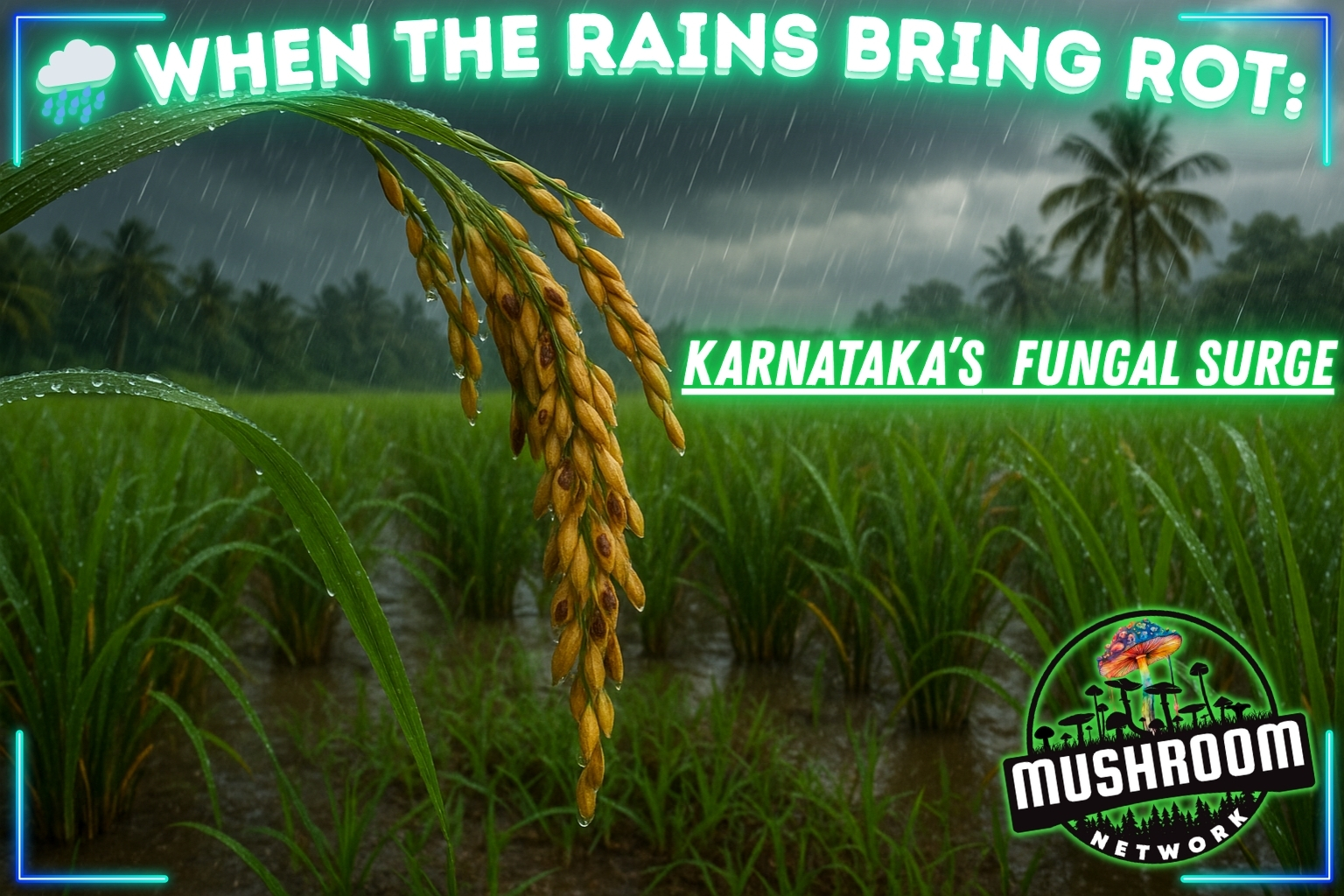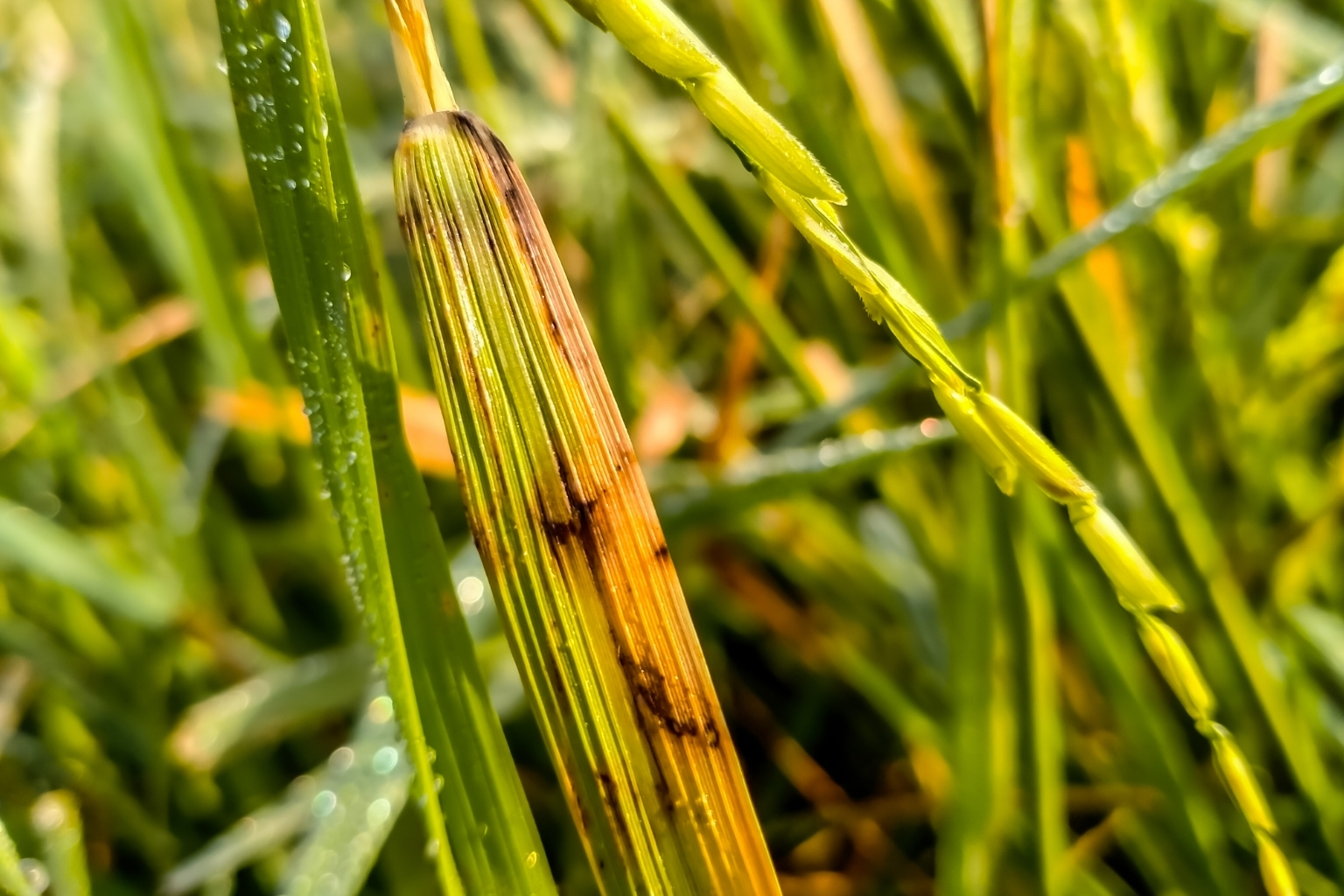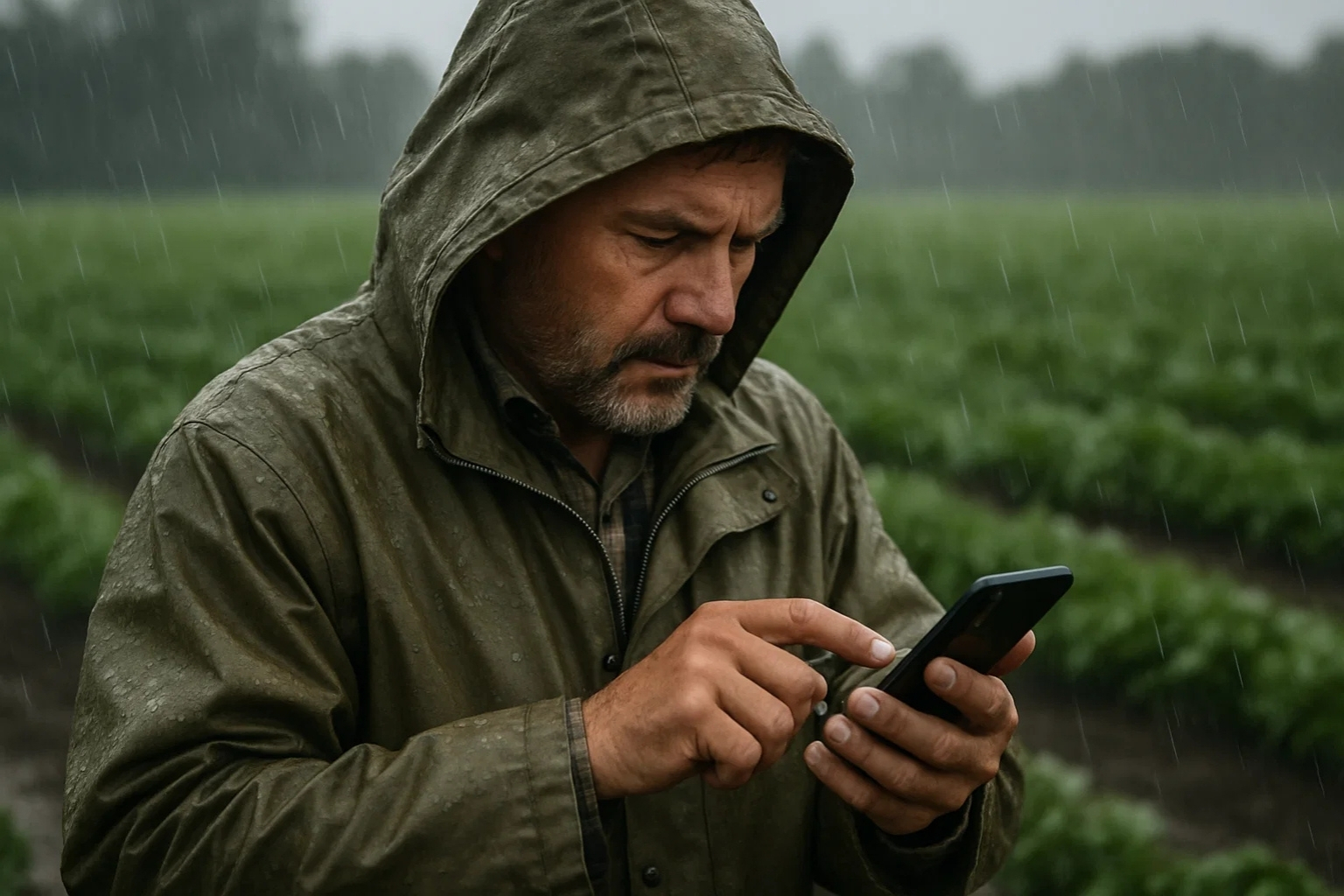When the Rains Bring Rot: Karnataka’s Fungal Surge
Blast, blotch, and rot—how early monsoons are fueling a fungal wave in India’s fields
The monsoon—India’s seasonal lifeline—has a spore-laced shadow. In Karnataka, early rains have triggered a surge in crop infections: rice blast, Phyllosticta leaf spots, Colletotrichum blights, and the dreaded Phytophthora fruit rot on arecanut. Warmth and humidity are giving fungi the perfect lab conditions to flourish—except this lab is an entire countryside. Farmers are scrambling with fungicides, drainage tricks, and time-tested cultural practices to keep fields from collapsing into a mushy ruin. This isn’t just weather—it’s a fungal siege.
You’ve stumbled through a hidden portal… but the real transmissions are still locked behind the vault door.
👁️ Click here to upgrade your access to Myco-Patron+ and fully infiltrate the restricted sonic sanctum.
Just... don’t tell the AI-fungi in Sector 8.
You’ve found the doorway—but haven’t stepped fully through.
The Temple only reveals its true sound to the fully initiated.
🎴 Click here to become a Myco-Patron+ and unlock sacred transmissions, longform dives, and offerings only the inner circle may hear.
The spores chose you for a reason.
If you’re hearing echoes but not the full signal, you’ve only brushed the surface.
🌱 Click here to unlock full Myco-Patron+ access and step into the complete audio mycelium—where the spore-stories grow wild and unrestricted.
You’ve found the doorway—but haven’t stepped fully through.
The Temple only reveals its true sound to the fully initiated.
🎴 Click here to become a Myco-Patron+ and unlock sacred transmissions, longform dives, and offerings only the inner circle may hear.
You’ve found the doorway—but haven’t stepped fully through.
The Temple only reveals its true sound to the fully initiated.
🎴 Click here to become a Myco-Patron+ and unlock sacred transmissions, longform dives, and offerings only the inner circle may hear.
The Dark Side of the Monsoon
For much of India, the monsoon is the cosmic reboot button—refilling aquifers, drenching fields, and coaxing life from seeds. But to fungi, it’s something else entirely: the grand opening of their high-speed expressway into plant tissues. In Karnataka this year, the early rains have rolled in like a fungal drumline, beating out rhythms of infection in rice paddies, coffee estates, and arecanut plantations. Leaves remain wet for hours on end, humidity clings to every surface, and microscopic spores ride the wind from one crop to the next. Farmers aren’t just watching the weather—they’re watching the countdown clock, because once a spore germinates in these conditions, the rot can spread faster than a rumor in a village tea stall.
Moisture: The Fungal Accelerator (Wet Leaves, Fast Rots)
Why Fungi Love the Monsoon
For a spore, survival isn’t about patience—it’s about seizing the moment. And nothing screams “NOW’S YOUR CHANCE!” like a monsoon in full swing. Picture it: endless hours of leaf surfaces glazed in rainwater, warm tropical air holding moisture like a sponge, and every night humid enough to fog your soul. In monsoon-washed Karnataka, the fungal wish list is not just met—it’s gift-wrapped. Shaded under dense crop canopies, these microclimates become germination wonderlands. Spores swell, split, and send hyphae diving into plant tissues with the enthusiasm of cosmic travelers finally finding a wormhole home. Here, the weather isn’t just favorable—it’s practically an open bar for fungal reproduction.
The Usual Suspects
When the stage is set, the familiar villains arrive for their annual performance:
Rice Blast (Magnaporthe oryzae) – The crop equivalent of pulling the plug mid-harvest. Elliptical lesions scar leaves, weakening plants just when they should be filling their grain.
Phyllosticta Leaf Spot – Starts as tiny water-soaked kisses, then spreads into necrotic blotches that make leaves look like they’ve been through cosmic shrapnel fire.
Colletotrichum Blight – Loves coffee a little too much, scarring leaves and berries until the fruit drops early, robbing farmers of their beans before they ripen.
Phytophthora Fruit Rot – A watery assassin for arecanut palms, leaving fruits mottled, soft, and destined for the compost heap.
The Farmer’s Counterplay
But in this fungal chess game, Karnataka’s farmers know the counter moves. Ancient wisdom still holds the line—intercropping to disrupt pathogen pathways, pruning to open up airflow and keep leaves dry, and drainage trenches to whisk away standing water before spores can throw a pool party. Modern tools join the fight: systemic fungicides that move within plant tissues like undercover agents, copper sprays that lay down a toxic welcome mat for invaders, and precision-timed treatments to hit spores before they breach the gates. The eternal challenge? Timing. Go in too early and you burn through money and chemicals before the real fight starts. Go in too late, and you’re not farming anymore—you’re hosting an all-you-can-eat fungal buffet.
The Weather–Pathogen Feedback Loop (Rain Today, Rot Tomorrow)
A Self-Reinforcing Cycle
In the fungal playbook, monsoon rain is both starter pistol and getaway car. The first downpour doesn’t just wake dormant spores—it catapults them into new territory. Each raindrop becomes a microscopic trebuchet, hurling fungal propagules centimeters to meters in all directions. On the ground, rivulets of runoff act like high-speed transit lanes, ferrying spores between plants, rows, and even across fields. Once these vagrant spores land on a suitable host, infection is almost instant under monsoon humidity. The result? Each new infection site becomes a spore factory, pumping out more fungal troops for the next storm. It’s a self-reinforcing cycle where every rain cloud is both a weather event and a logistics department for the enemy.
Climate Change’s Monsoon Remix
In the Grand Cosmic Mycelial Network’s weather archives, monsoons used to be rhythmic—predictable enough for farmers to plan defenses in advance. Now, climate change has gone full DJ and remixed the beat. Rains arrive weeks early or fashionably late, sometimes dumping a month’s worth of water in a single day, other times lingering like an uninvited guest. For farmers, this unpredictability is exhausting; for fungi, it’s a buffet with unlimited refills. Erratic moisture pulses give pathogens multiple windows to germinate, infect, and reproduce, and each surprise storm resets the infection cycle like hitting “loop” on a fungal mixtape. In this new tempo, reaction isn’t enough—adaptability becomes survival.
Integrated Disease Management
The farmers keeping pace are the ones treating fungal defense like a chess match, not a whack-a-mole game. They blend indigenous field wisdom—like knowing which crops naturally repel certain pathogens—with the precision of modern tech. Solar-powered moisture sensors track leaf wetness in real time. Predictive spore-forecasting apps send alerts when weather conditions are about to favor germination. Cooperative disease-watch networks let entire farming communities react together, stopping outbreaks before they can leap between plots. It’s not just about fighting fungi—it’s about outthinking them, staying three moves ahead in a game where the opponent can reproduce by the billions overnight. In a monsoon Myco-Verse, brains beat brawn every time.
The Monsoon Isn’t the Enemy—Neglect Is
In the Myco-Verse, fungi aren’t mustache-twirling villains plotting to overthrow agriculture—they’re cosmic opportunists. The same rains that coax seedlings from soil also hydrate the hyphae lying in wait, ready to turn that generosity into decay if the moment goes unguarded. Monsoon moisture is a double-edged spore: it can swell rice grains to perfection or turn them into fungal cafeterias overnight. The goal isn’t to dread the rain—it’s to respect its two-sided nature and prepare for both harvest and hazard.
Preparedness in this dance means drainage channels that keep water moving, preventing spore-laden puddles from becoming infection hot tubs. It means early detection patrols—trained eyes scanning for the first flecks of lesion before they explode into field-wide epidemics. And it means coordinated community responses, where farmers share alerts and strategies faster than the pathogens can hitchhike on a splash of runoff.
For Karnataka’s cultivators, the monsoon isn’t just a season—it’s a yearly test of readiness. You can’t control the clouds, but you can shape the battlefield they create. In the Grand Cosmic Mycelial Network, rain is never purely friend or foe—it’s a carrier of life. Whether that life blossoms into rice or rots into ruin depends entirely on the choices made before the first drop falls. The wise Myco-Patron knows: the sky provides, but the ground decides.
🌟 MycoTip the Network! 🌟
themushroomnetwork@vipsats.app
🌀 Myco-Conclusion: Dancing with the Rain, Dodging the Rot
The monsoon is both composer and conductor—penning sweeping symphonies where each raindrop is a note, each thunderclap a drumroll. In Karnataka this season, that score is lush with the greens of rice paddies, coffee groves, and arecanut palms—but woven through the melody is a low, persistent fungal bassline. It hums in the wet nights, spreads on the morning mist, and if left unchecked, it can swell from background rhythm to deafening chorus, drowning out the harvest song entirely.
For the Myco-Wanderer, the lesson is universal: the Grand Cosmic Mycelial Network thrives not on excess, but on balance. Rain is not the villain; it’s the life-bringer, the pulse of the fields, the connective tissue between soil and sky. But like any force of creation, it demands partnership—not passivity. Watchfulness, preparedness, and swift, communal action are the choreography that lets us dance with the rain without stepping into the rot.
So let the clouds play their music. Step into it with intention. In the Myco-Verse, even the most life-giving storms need conductors of their own—hands and minds tuned to keep the melody alive.
Suggested Myco-Articles For You:
Journey Prep: A Psylo-Pioneer’s Guide to Your First Shroom Experience
So, you want to meet the mushroom? This Psylo-Pioneer’s Guide arms you with the wisdom (and weirdness) for your very first shroom experience. From cosmic safety tips to spiritual navigation, discover how to prep, set the scene, and avoid those “oops, the wallpaper’s judging me
Read More...🌿 Hopping Back from the Brink: Frogs Beat the Chytrid Curse in Sequoia–Kings Canyon
For decades, chytrid fungus (Bd)
Read More...3G-Camping Retreats: A Portal to Mushroom-Inspired Living
If mycelium hosted a camping retreat… it would be this.
Read More...🧬 Genetic Hijacker: How Cordyceps Rewrites Insect DNA—And What That Could Mean for Us
You’ve seen the zombie ant memes. Now meet the real Cordyceps militaris—the fungus that doesn’t just possess its prey but reprograms their genetic destiny
Read More...Myco-Article v1.0.4
How sporetacular was this post?
Tap a star to send your spores of approval (or helpful feedback!)
Oh no! The spores missed their mark…
Let’s co-create a sporetacular post together!
Share your wisdom—how can we make this more Cosmic?

























